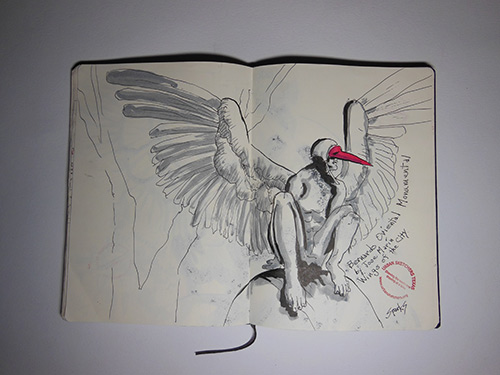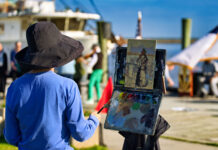The artists in Urban Sketchers Texas found many positives in depicting a citywide exhibit of outdoor sculptures in Fort Worth recently, including one of the primary joys of urban sketching itself.
Lead Image: A series of sketches by James Richards depicting sculptures in the “Wings of the City” exhibition in Fort Worth, Texas
From June 7 to August 31, nine large bronze sculptures by Mexican artist Jorge Marín were installed in public parks in Fort Worth. The show was called “Wings of the City,” and all but one of the sculptures depicted humans with bird-like features. The last and most popular of the sculptures consisted solely of wings, and it was situated prominently in a way that allowed the public to step up to it and appear to have giant wings. “There was a perpetual line of people waiting to have their moment as an angelic being,” says James Richards, the founder of Urban Sketchers Texas. “But most of the sculptures weren’t even noticed — they were in nooks and crannies where most people didn’t even see them.”

That seemed like a job for urban sketchers. After all, what do urban sketchers do better than allow residents of a town to see their city in a new way, to notice things they may not have noticed?

“One of the things that I really love about urban sketching is the fact that we are going out and doing something we love — I can’t imagine a better way to spend our time,” says Richards. “Whether it’s the city you love or a city you visit when you travel, you are observing more closely and learning much more because you are observing more deeply and slowly. At the same time, in public you will always have people come over to see what you are doing. Chances are really good the observers have never looked at that building or sculpture or park in the same way that you are. You are improving their appreciation of it. You are creating a more appreciative audience for what you are doing — and for your city. It doesn’t get any better than that.”

This particular outing for the Urban Sketchers Texas attracted a larger-than-usual group — 35 artists. The sketchers were accompanied by two docents provided by the Fort Worth Public Arts group behind the installation, who gave some background on each sculpture as the group went on their walking tour. They sketched for 30 minutes at each spot. At the end, Richards helped lead the group’s traditional “sketchbook throwdown,” in which all the sketchers lay out their drawings and talk about what they learned.

Another aspect the sketchers enjoyed was the process of depicting another artist’s work. “Artists have always gone into museums to study work by the masters, including sculptures, and then they learn from it through their sketchbooks,” says Richards. “But putting it on paper really transformed the work. Some of us tiled our different views together to create a new piece about a sculpture. That produced some pretty interesting work. Also, these sculptures were human figures based on real models. A lot of the models were gymnasts, so we are talking about perfection in the human form.”

Richards was thankful for the sketch crawl from sculpture to sculpture. “Like so many others in the city, I noticed the one that was simply wings long before I saw any of the others,” he says. “What was great about that piece is that it was acting as a catalyst to make people walk around and participate with it. Watching people interact with it was part of the fun. But the way some of the pieces were placed, they weren’t as well appreciated — or were completely ignored. We could add something new to it, another layer, another way to access them.”




